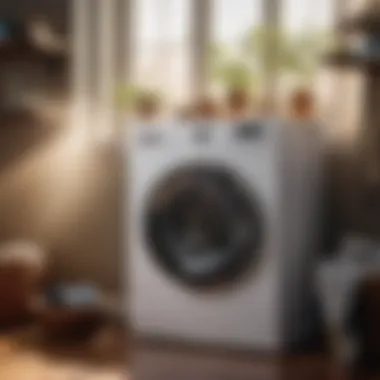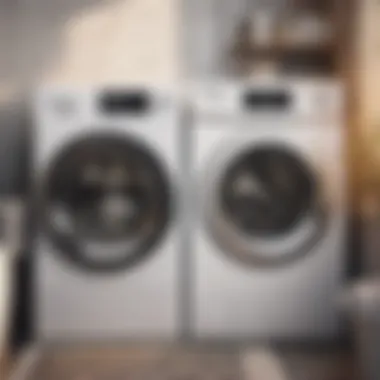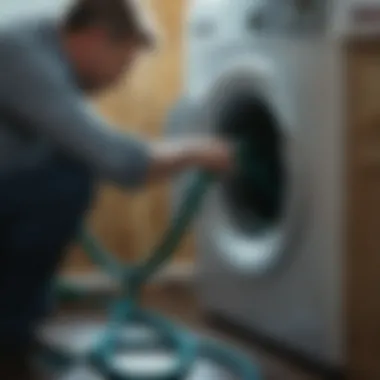Troubleshooting a Leaking Laundry Machine: Expert Solutions Unveiled


Materials:
- 1.5 meters of rubber hose
- Adjustable wrench
- Screwdriver set
- Towels
- Bucket
- Flashlight
DIY Steps:
- Turn Off Water Supply: Locate the shut-off valve for the water supply to the washing machine and turn it off to prevent any water flow.
- Unplug and Disconnect: Unplug the washing machine from the power source and carefully disconnect the hoses.
- Inspect Hoses: Check the hoses for any visible signs of damage or wear. Replace if necessary.
- Replace Rubber Gaskets: Inspect and replace any worn rubber gaskets to ensure a proper seal.
- Reconnect Hoses: Reconnect the hoses securely, ensuring no kinks or twists.
- Run Test Cycle: Plug the machine back in, turn on water supply, and run a test cycle to check for leaks.
Technical Aspects:
- Timing: Allocate 1-2 hours for this project, depending on complexity.
- Tools: Use an adjustable wrench and screwdriver set for hose and gasket replacement.
- Critical Techniques: Ensure proper alignment and secure connections to prevent leaks.
DIY Project Process:
- Begin by gathering all materials and tools in a well-lit area.
- Proceed with caution when handling water connections to avoid spills or accidents.
- Take your time to inspect and replace any damaged components meticulously.
Troubleshooting Tips:
- If leaks persist, double-check hose connections and tighten if necessary.
- Ensure all components are aligned correctly to prevent future leaks.
- Contact a professional if the issue persists after following troubleshooting steps.
Understanding the Basics
Identifying the Leakage
Check for Visible Water
When it comes to troubleshooting a leaking laundry machine, a fundamental aspect is checking for visible water accumulations around the appliance. This step is pivotal as it helps pinpoint the exact source of the leak, whether it is originating from the machine itself or external factors. By examining visible water leaks, individuals can assess the severity of the issue and take necessary actions promptly. While detecting visible water may seem simple, it is a critical diagnostic tool that can lead to effective problem-solving techniques and prevent further damage to the machine, ultimately prolonging its lifespan.
Inspect the Floor Under the Machine
Inspecting the floor under the laundry machine is a vital step in identifying leaks, especially in cases where water may have dripped onto the floor during operation. This inspection allows individuals to detect leaks that may not be immediately visible on the machine itself. By carefully examining the floor for signs of moisture or pooling water, homeowners can determine whether the leak stems from a localized issue or a more widespread problem within the appliance. This proactive approach to leak identification enables swift intervention and helps prevent potential water damage to surrounding areas.
Examine Surrounding Areas for Moisture
In understanding the basics of leak detection in laundry machines, examining surrounding areas for moisture is essential to uncover hidden sources of leaks. Moisture detection in adjacent walls, cabinetry, or flooring can indicate underlying issues with the machine's internal components or drainage system. By conducting a thorough examination of the environment surrounding the machine, individuals can gain a comprehensive view of the leak's extent and take corrective measures to address the root cause effectively. This step enhances the precision of troubleshooting efforts and facilitates timely repairs, minimizing the chances of recurring leaks in the future.
Types of Leaks


Top-Loading Machines
Top-loading machines present a unique set of challenges when it comes to leaks, often related to issues with the machine's water inlet, drainage system, or overloading. Understanding how top-loading machines differ from their front-loading counterparts is crucial in diagnosing and resolving leaks efficiently. By exploring specific characteristics and common leak sources in top-loading machines, users can develop targeted strategies to mitigate the risk of water damage and maintain proper functionality.
Front-Loading Machines
Front-loading machines offer distinct advantages and challenges in leak detection and prevention due to their design and operating mechanisms. Leaks in front-loading machines commonly stem from issues with the door seal, drainage pump, or detergent dispenser. Recognizing the unique features and potential leak points in front-loading machines is essential for homeowners to implement preventative measures effectively. By addressing leaks in front-loading machines promptly, individuals can uphold the appliance's performance and longevity, avoiding costly repairs and water-related damages.
Soap Dispenser Overflow
Soap dispenser overflow is a frequent issue that can lead to leaks in laundry machines if left unattended. This type of leak often occurs due to detergent residue buildup or improper loading of the dispenser. Identifying the causes and consequences of soap dispenser overflow is critical for maintaining a leak-free laundry environment. By familiarizing themselves with the intricacies of soap dispenser functionality and maintenance, users can prevent overflow-related leaks, ensuring smooth operation and optimum cleaning results from their machines.
Common Causes of Leaks
Faulty Door Seals
Faulty door seals are a prevalent cause of leaks in laundry machines, affecting both top-loading and front-loading models. A compromised door seal can allow water to escape during the wash cycle, leading to water accumulation around the machine. Understanding the implications of faulty door seals and recognizing the signs of deterioration is essential for timely repair or replacement. By addressing door seal issues promptly, homeowners can mitigate the risk of leaks and preserve the integrity of their laundry appliances.
Clogged Drainage System
A clogged drainage system can result in leaks and water backup in laundry machines, causing operational disruptions and potential water damage. Clearing obstructions in the drainage system, such as lint, debris, or foreign objects, is crucial for maintaining proper water flow and preventing leaks. Recognizing the symptoms of a clogged drainage system and implementing proactive cleaning measures can safeguard the machine against leaks and ensure consistent performance over time.
Loose Connections
Loose connections within the laundry machine's plumbing and hose network can contribute to leaks and water seepage during operation. Inspecting and tightening loose connections regularly is essential for preventing leaks and optimizing water efficiency. By addressing loose connections promptly and securing fittings snugly, users can minimize the risk of water leaks and maintain the appliance's structural integrity. This proactive maintenance approach enhances the longevity of the machine and reduces the likelihood of costly repairs due to water-related damages.
Diagnosing the Issue
Diagnosing the issue is a critical aspect of this comprehensive guide as it lays the foundation for effectively troubleshooting and resolving the leaking problem in your laundry machine. By understanding the root cause of the leak, homeowners can address the issue promptly and prevent further damage to the appliance or surrounding areas. Proper diagnosis not only saves time and money but also ensures the smooth functioning of the laundry machine in the long run.
Internal Inspection
When it comes to the internal inspection of a leaking laundry machine, focusing on checking hoses and connections is paramount. The integrity of hoses and connections directly impacts the machine's water containment capability. Regularly inspecting these components can help identify potential leaks, blockages, or damages, allowing for timely repairs and maintenance. Ensuring proper functioning of hoses and connections is crucial for preventing future leaks and maintaining the efficiency of the machine.
Check Hoses and Connections
Checking hoses and connections involves examining the flexible tubes responsible for water inflow and outflow in the laundry machine. Any cracks, kinks, or loose connections in these hoses can lead to leaks and water spillage. By closely inspecting these components, homeowners can detect issues early on and take appropriate corrective measures. Regular maintenance of hoses and connections is key to preventing water leakage and ensuring the smooth operation of the appliance.
Inspect Pump and Filter


Inspecting the pump and filter is another essential aspect of internal inspection when dealing with a leaking laundry machine. The pump is responsible for draining water from the machine, while the filter helps trap debris and prevent clogs. Ensuring that the pump is functioning correctly and the filter is clean is crucial for preventing water leaks and maintaining the machine's performance. Regular inspection and maintenance of these components can help address potential issues before they escalate.
Examine Tub for Damage
Examining the tub for damage is a crucial step in diagnosing a leaking laundry machine. The tub, where the clothes are loaded for washing, should be free of cracks, corrosion, or leaks. Any damage to the tub can result in water seepage during the wash cycle, leading to leaks on the floor. Regularly checking the tub for signs of wear and tear or deterioration is essential for preventing leaks and ensuring the longevity of the appliance.
External Factors
Apart from internal inspection, external factors also play a significant role in addressing a leaking laundry machine. Factors such as leveling the machine, checking the water supply, and assessing overloading can impact the machine's overall performance and potential for leaks. Considering and addressing these external factors is crucial for effective troubleshooting and maintenance of the appliance.
Leveling the Machine
Ensuring that the laundry machine is properly leveled is essential for preventing leaks and optimizing its performance. An unevenly placed machine can cause vibrations during the spin cycle, leading to water spillage and leaks. By adjusting the machine's leveling legs accurately, homeowners can enhance its stability and reduce the likelihood of leaks. Properly leveled machines not only operate more efficiently but also have a lower risk of developing leaks over time.
Checking Water Supply
Checking the water supply to the laundry machine is a critical step in diagnosing leaks. Issues such as low water pressure, kinked hoses, or faulty valves can contribute to water leaks during the wash cycle. Ensuring that the water supply is adequate, unrestricted, and properly connected to the machine is essential for preventing leaks and maintaining the appliance's functionality. Regularly inspecting the water supply components can help identify and address potential issues before they cause significant damage.
Assessing Overloading
Overloading the laundry machine with clothes can lead to strain on its internal components, potentially causing leaks. Assessing the load capacity of the machine and avoiding overloading can prevent excessive wear and tear on seals, hoses, and other vital parts. By following the manufacturer's guidelines on load capacity and washing cycles, homeowners can reduce the risk of leaks and prolong the lifespan of the machine. Preventing overloading not only safeguards the appliance from leaks but also ensures efficient cleaning outcomes.
Troubleshooting Steps
In this comprehensive guide on troubleshooting a leaking laundry machine, the section on Troubleshooting Steps plays a crucial role in aiding homeowners in effectively identifying, diagnosing, and resolving potential leakage issues. By following a structured approach outlined in this article, individuals can proactively address any leaks in their laundry machines to ensure optimal functionality and prevent further damage. Emphasizing the significance of Troubleshooting Steps, this section provides clear and concise guidelines for users to navigate through common issues and take necessary actions to rectify them.
Basic Maintenance
Cleaning Filters and Drains
When it comes to maintaining a laundry machine, a key aspect is Cleaning Filters and Drains. This practice involves regular inspection and cleaning of filters and drains within the machine to prevent clogs and ensure smooth water flow during the washing process. By incorporating this maintenance task into a routine, individuals can improve the overall efficiency and longevity of their appliances. The unique feature of Cleaning Filters and Drains lies in its ability to prevent build-up of debris and residue, which can lead to blockages and potential leaks. While it requires time and effort, the advantages of this maintenance step include reducing the risk of malfunctions and prolonging the life of the machine.
Inspecting Hoses Regularly
Another vital aspect of basic maintenance is Inspecting Hoses Regularly. By routinely checking the condition of hoses connected to the laundry machine, individuals can identify potential leaks or damage early on, allowing for timely repairs and minimizing the risk of water leakage. The key characteristic of this practice is its preventative nature, as it enables homeowners to detect issues before they escalate into major problems. The unique feature of regularly inspecting hoses is the opportunity to address minor issues promptly, thereby avoiding costly repairs and water damage in the long run.
Using Recommended Detergents
Using Recommended Detergents is essential for maintaining both the effectiveness of the laundry process and the longevity of the machine. Opting for detergents approved by the manufacturer not only ensures optimal cleaning results but also helps preserve the internal components of the appliance. The key characteristic of using recommended detergents is their compatibility with the machine's mechanisms, reducing the risk of residue build-up and potential leaks. While there may be specific detergents recommended for different machine models, adhering to these guidelines can contribute to improved performance and a longer lifespan for the appliance.


Repair Considerations
Replacing Seals and Gaskets
When addressing leakage issues in a laundry machine, one common repair consideration is Replacing Seals and Gaskets. By replacing worn-out or damaged seals and gaskets, individuals can effectively prevent water leakage and restore the machine's sealing integrity. The key characteristic of this repair task is its ability to seal gaps and prevent moisture from escaping, thereby maintaining the efficiency of the appliance. While the process of replacing seals and gaskets may require some technical expertise, the advantages include preventing potential leaks and maintaining the overall performance of the machine.
Fixing Drainage Issues
Another critical repair consideration is Fixing Drainage Issues, which involves troubleshooting and resolving problems related to the machine's drainage system. By addressing issues such as clogs or blockages in the drainage pipes, individuals can prevent water from backing up and causing leaks during the washing cycle. The key characteristic of fixing drainage issues is its impact on preventing water accumulation, which can lead to overflow and leakage. While this repair task may involve disassembling parts of the machine, the benefits include efficient drainage and reduced risk of water damage.
Calling a Professional
For complex or persistent leakage problems, Calling a Professional may be the most effective solution. Professional repair services can provide expertise in diagnosing and repairing intricate issues within the laundry machine, offering a lasting fix to prevent future leaks. The key characteristic of seeking professional help is the assurance of skillful repair work and comprehensive troubleshooting to address underlying problems. While the cost of professional services may be higher, the advantages include accurate diagnosis, quality repairs, and peace of mind for homeowners seeking a reliable solution to their leakage issues.
Preventive Measures
Preventive measures are crucial to maintaining the longevity and efficiency of your laundry machine. In this insightful article, we delve into the specific elements that contribute to the preventative maintenance of your appliance. By following these preventive measures, you can prolong the lifespan of your machine and avoid costly repairs down the line. Taking proactive steps to care for your laundry machine ensures smooth operation and optimal performance.
Regular Maintenance Tips
Cleaning the Machine Properly
Cleaning the machine properly is a fundamental aspect of preventive maintenance. This meticulous cleaning process involves removing any built-up residue, lint, or debris from the various components of the machine. By regularly cleaning your machine, you can prevent clogs, leaks, and operational issues. It is a popular choice for maintaining the cleanliness and functionality of the appliance. The unique feature of cleaning the machine properly is its ability to enhance performance and minimize the risk of malfunctions. However, improper cleaning techniques can potentially damage sensitive parts, so it is essential to follow manufacturer guidelines.
Checking Water Pressure
Monitoring water pressure is essential for the proper functioning of your laundry machine. Proper water pressure ensures efficient cleaning and rinsing cycles. Low water pressure can lead to inadequate cleaning, while high water pressure can strain the machine's components. This careful check helps maintain optimal performance, preventing damage to the machine. The unique feature of checking water pressure lies in its ability to optimize washing results while conserving water and energy. However, excessive water pressure can cause leaks or damage, emphasizing the need for regular monitoring.
Avoiding Overloading
Avoiding overloading your machine is a key preventive measure to safeguard its longevity. Overloading can strain the motor, bearings, and other parts, leading to premature wear and tear. By following load capacity guidelines, you prevent excessive strain, reduce the risk of malfunctions, and ensure proper cleaning. The distinctive feature of avoiding overloading is its ability to maintain optimal performance and extend the lifespan of your machine. However, consistently overloading the machine can result in imbalanced loads, reduced efficiency, and potential breakdowns, underscoring the importance of adhering to recommended loads.
Professional Inspection Benefits
Scheduled Service Calls
Scheduling regular service calls with professionals is a proactive approach to keeping your laundry machine in top condition. Professional technicians can identify and address minor issues before they escalate, ensuring uninterrupted operation. The key characteristic of scheduled service calls is their capacity to detect potential problems early, preventing costly repairs. This service offers convenience and peace of mind, but it may incur additional costs based on the scope of inspection and maintenance required.
Early Problem Detection
Detecting problems early is paramount in maintaining a healthy laundry machine. Early problem detection allows for timely intervention, minimizing the impact on the appliance's functionality. The key characteristic of early problem detection is its ability to prevent small issues from evolving into major faults, ultimately saving time and money. This proactive approach enhances the longevity and efficiency of your machine. Nonetheless, it may require diligence in observing and monitoring your appliance's performance to catch issues promptly.
Long-Term Machine Health
Ensuring the long-term health of your machine involves comprehensive care and maintenance. By investing in regular inspections and upkeep, you protect your appliance from wear and tear, extending its lifespan. The key characteristic of long-term machine health is its focus on sustainable performance and durability. This approach contributes to cost savings in the long run by avoiding premature replacements and major repairs. However, prioritizing long-term machine health necessitates a commitment to consistent maintenance practices and adherence to manufacturer guidelines.







